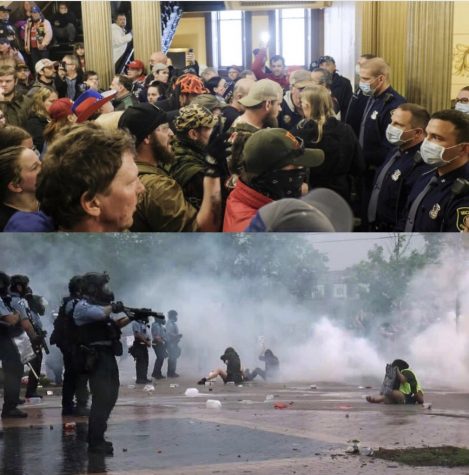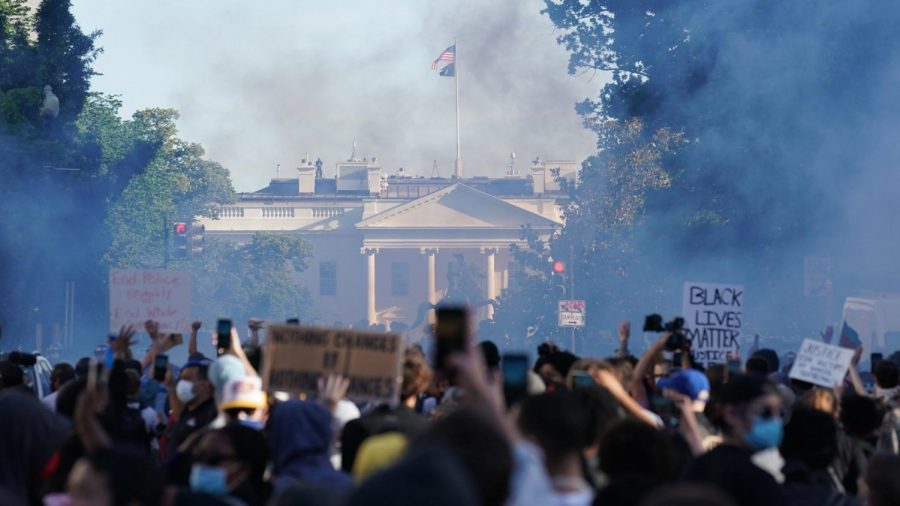The Right or the Privilege to Protest?
CreditCredit…Erin Schaff/The New York Times
Police use teargas on protestors outside the White House.
June 2, 2020
Minnesota has seen its fair share of protests this month. Like other state capitals, St. Paul was the site of anti-lockdown protests in response to Governor Tim Waltz’s two-week extension of the stay-at-home order. The vast majority of protesters were white—some even carried weapons—and were met with almost no police interaction. Flashforward to this week as tensions flared in Minneapolis, where thousands took to the streets to protest the unjust murder of George Floyd, a black man killed by four policemen. Similarly to previous Black Lives Matter protests, the vast majority of demonstrators were not violent, nor were any armed, that is until the incidents of Thursday night and further on. The first three days were peaceful, but that did not stop the police from running absolutely rampant.
This is just a miniscule fragment of a much greater issue in the nation.
The First Amendment protects citizens’ right to peacefully protest. And yet, police and other armed forces have taken it upon themselves to decide who that right applies to. It is evident that, to them, “We the people” does not apply to black people.
Before the events over George Floyd’s death unfolded, the anti-lockdown protests have been at the center of the controversial “white privilege” debate. Various images of armed white men and women holding elitist posters saying “We need haircuts” and “Lockdown is slavery” have been compared to members of minority communities rallying against issues such as police brutality and detainment camps. Governors Gretchen Whitmer (MI), Andrew Cuomo (NY), and Gavin Newsom (CA) became targets of numerous threats containing criminal and explicit matters. Protestors even marched into some state capitol buildings, gripping rifles and shouting at guards who stood still. No one flinched. Michigan State Senator Danya Polehanki took to Twitter to say that she and several colleagues wore bulletproof vests to go to work at the capitol, while a few other state governments opted for virtual meetings to ensure the safety of all officials.

The most commonly asked question upon seeing such a scene reveals a heinous testament of our society. What if one of the protestors was infected with COVID-19 and spread it? Are these protests going to delay the recovery time of the nation? Isn’t threatening government officials illegal?
What if they were black?
The Black Lives Matter protests started the day after Floyd’s death. Apart from a small group who threw rocks and vandalized police vehicles, most protestors simply marched through the streets of Minneapolis, clad in masks and holding signs reading, “He couldn’t breathe” and “Justice for Floyd.” Despite such peaceful sentiments, police treatment towards the protests was deplorable. Police began launching flash grenades, spraying teargas, and shooting rubber bullets at the masses—an inexcusable barrage of violence in response to some graffiti. This pattern occurred for three days until an act of violence was first perpetrated and all hell broke loose. Last Thursday night, rioters set the Third Precinct in Minneapolis on fire, acting as a catalyst as outbreaks and outrage erupted nationwide, from looting to destruction of various buildings to full-blown brawls. In offering his support to the movement, Minneapolis Mayor Jacob Frey expressed a potent message at a press conference: “Bricks and mortar are not as important as life. The symbolism of a building cannot outweigh the significance of life.” Although this violence is what is highlighted in the media, the majority of protests remain peaceful.
Violence in any way is unjust and intolerable by any means. But it is imperative to understand why the protesters turned to rioting. They tried kneeling. They tried peaceful rallies. They tried marches. They tried walk-outs. They tried sit-ins. But they just could not win. There cannot be peace so long as there is no justice.
Martin Luther King Jr. is one of the most celebrated social activists to date. As we remember him every third Monday of January and commend him in our history books, what gets disregarded is precisely just how hated he was when he was alive. A 1968 Harris Poll conducted the week of his death showed King had a public disapproval rate of almost 75%. King’s marches and the Civil Rights Movement were not as glamorous as the history books paint them to be. The FBI wrote to King what is referred to as the “suicide letter,” insulting and threatening him in an attempt to silence him and curb the growing influence of the movement. And though King and other leaders of the movement advocated for only peaceful protests, police employed aggressive tactics to quell demonstrations. Protests were met with bullets, beatings from batons, and fire hoses.
Forty-one people died from this excessive violence. Forty-one people died from this malice. Forty-one people died to create a better future and society. Forty-one people died only for their progeny to be fighting the same fight 50 years later.
Forty-one people died only to fight again for justice for Arthur McDuffie in 1980. Forty-one people died only to fight again for justice for Rodney King in 1992. Forty-one people died only to fight again for justice for Trayvon Martin in 2012. Forty-one people died only to fight again for justice for Michael Brown in 2012. Forty-one people died only to fight again for justice for Alton Sterling in 2016. And forty-one people died only to fight again for justice for George Floyd in 2020.
In response to the riots, Martin Luther King III tweeted, “As my father explained during his lifetime, a riot is the language of the unheard.” For decades, black people have peacefully protested civil injustices and systematic oppression, only to be met with teargas, rubber bullets, and the disturbing realization that their efforts are not enough. In a system where institutionalized racism is cemented into its foundations, change is past due. The only remaining question is how.

















































































































































